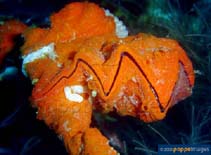Dendostrea folium (Linnaeus, 1758)
Leaf oysterWarning: DOMDocument::load(): SSL operation failed with code 1. OpenSSL Error messages: error:140770FC:SSL routines:SSL23_GET_SERVER_HELLO:unknown protocol in C:\Apache24\htdocs\includes\SpeciesSummary.lib.php on line 1236
Warning: DOMDocument::load(): Failed to enable crypto in C:\Apache24\htdocs\includes\SpeciesSummary.lib.php on line 1236
Warning: DOMDocument::load(https://sealifebase.nrm.se/webservice/AquaMaps/getAMap.php?genus=Dendostrea&species=folium): failed to open stream: operation failed in C:\Apache24\htdocs\includes\SpeciesSummary.lib.php on line 1236
Warning: DOMDocument::load(): I/O warning : failed to load external entity "https://sealifebase.nrm.se/webservice/AquaMaps/getAMap.php?genus=Dendostrea&species=folium" in C:\Apache24\htdocs\includes\SpeciesSummary.lib.php on line 1236
Classification / Names Common names | Synonyms | CoL | ITIS | WoRMS
| Ostreida | Ostreidae
Environment: milieu / climate zone / depth range / distribution range Ecologia
; distribuzione batimetrica 0 - 28 m (Ref. 75840). Tropical
Distribuzione Stati | Aree FAO | Ecosystems | Presenze | Introduzioni
Indo-West Pacific: from East Africa, to Melanesia; north to Japan and south to Queensland.
Length at first maturity / Size / Peso / Age
Maturity: Lm ? range ? - ? cm Max length : 10.0 cm SHH maschio/sesso non determinato; (Ref. 348); common length : 6.0 cm SHH maschio/sesso non determinato; (Ref. 348)
On rocks or sea whip stems. Common in mangrove areas (Ref. 348). Also found in mud, rubble, and shell hash (Ref. 75840). Shallow sublittoral, on boulders and corals (Ref. 127083).
Life cycle and mating behavior Maturità | Riproduzione | Deposizione | Uova | Fecundity | Larve
Members of the class Bivalvia are mostly gonochoric, some are protandric hermaphrodites. Life cycle: Embryos develop into free-swimming trocophore larvae, succeeded by the bivalve veliger, resembling a miniature clam.
Main reference
Bibliografia | Coordinatore | Collaboratori
Poutiers, J.M. 1998. (Ref. 348)
IUCN Red List Status (Ref. 130435)
CITES status (Ref. 108899)
Not Evaluated
CMS (Ref. 116361)
Not Evaluated
Threat to humans
Harmless
Human uses
| FishSource |
Strumenti
Informazioni ulteriori
Age/Size
Accrescimento
Length-weight
Length-length
Morfologia
Larve
Abbondanza
Accrescimento
Length-weight
Length-length
Morfologia
Larve
Abbondanza
Fonti Internet
BHL | BOLD Systems | CISTI | DiscoverLife | FAO(Publication : search) | Fishipedia | GenBank (genome, nucleotide) | GloBI | Gomexsi | Google Books | Google Scholar | Google | PubMed | Tree of Life | Wikipedia (Go, ricerca) | Zoological Record
Estimates based on models
Preferred temperature
(Ref. 115969): 23.9 - 29.2, mean 28.3 (based on 2997 cells).
Price category
(Ref. 80766):
Unknown.



